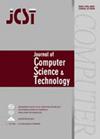基于塔布搜索的 Qubit 映射
IF 1.3
3区 计算机科学
Q4 COMPUTER SCIENCE, HARDWARE & ARCHITECTURE
引用次数: 0
摘要
量子位映射的目标是在可接受的时间内,通过引入尽可能少的附加门,将逻辑电路映射到物理设备。我们提出了一种名为基于塔布搜索调整(Tabu Search Based Adjustment,TSA)算法的有效方法来构建映射。它由两个关键步骤组成:一个是利用子图同构和补全组合来初始化一些候选映射,另一个是通过 TSA 动态修改映射。我们的实验表明,与最先进的方法相比,TSA 可以用较少的额外门数生成映射,对大规模电路具有更好的可扩展性。本文章由计算机程序翻译,如有差异,请以英文原文为准。
Qubit Mapping Based on Tabu Search
The goal of qubit mapping is to map a logical circuit to a physical device by introducing additional gates as few as possible in an acceptable amount of time. We present an effective approach called Tabu Search Based Adjustment (TSA) algorithm to construct the mappings. It consists of two key steps: one is making use of a combined subgraph isomorphism and completion to initialize some candidate mappings, and the other is dynamically modifying the mappings by TSA. Our experiments show that, compared with state-of-the-art methods, TSA can generate mappings with a smaller number of additional gates and have better scalability for large-scale circuits.
求助全文
通过发布文献求助,成功后即可免费获取论文全文。
去求助
来源期刊

Journal of Computer Science and Technology
工程技术-计算机:软件工程
CiteScore
4.00
自引率
0.00%
发文量
2255
审稿时长
9.8 months
期刊介绍:
Journal of Computer Science and Technology (JCST), the first English language journal in the computer field published in China, is an international forum for scientists and engineers involved in all aspects of computer science and technology to publish high quality and refereed papers. Papers reporting original research and innovative applications from all parts of the world are welcome. Papers for publication in the journal are selected through rigorous peer review, to ensure originality, timeliness, relevance, and readability. While the journal emphasizes the publication of previously unpublished materials, selected conference papers with exceptional merit that require wider exposure are, at the discretion of the editors, also published, provided they meet the journal''s peer review standards. The journal also seeks clearly written survey and review articles from experts in the field, to promote insightful understanding of the state-of-the-art and technology trends.
Topics covered by Journal of Computer Science and Technology include but are not limited to:
-Computer Architecture and Systems
-Artificial Intelligence and Pattern Recognition
-Computer Networks and Distributed Computing
-Computer Graphics and Multimedia
-Software Systems
-Data Management and Data Mining
-Theory and Algorithms
-Emerging Areas
 求助内容:
求助内容: 应助结果提醒方式:
应助结果提醒方式:


